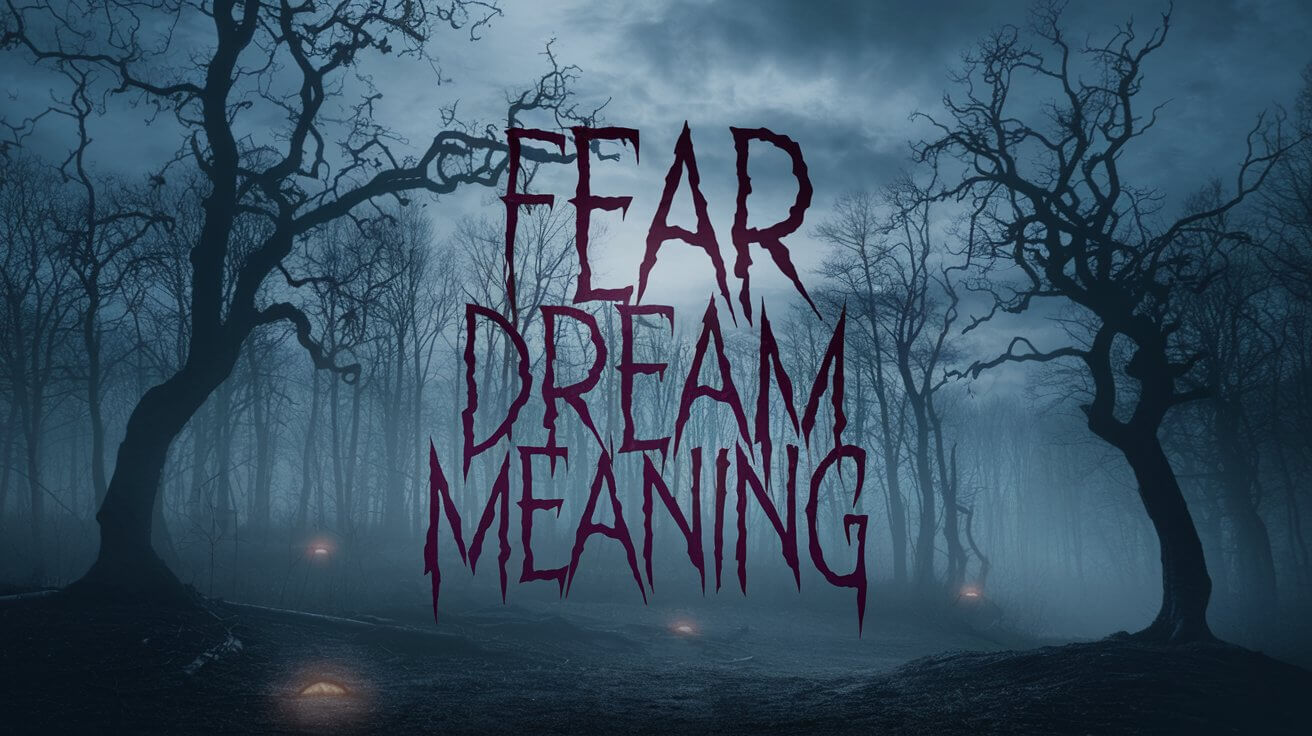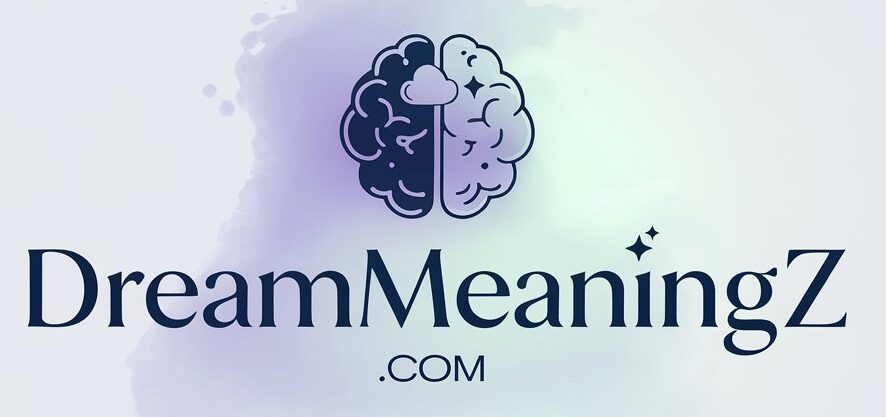Fear Dream Meaning

Dreams can reveal our hidden fears and insecurities. Fear-based dreams are key in understanding our emotions. They show our deepest worries and help us face them, leading to growth and self-awareness.
Fear dreams often deal with real threats to us or our loved ones. Symbols in these dreams can be wild animals, natural disasters, or unknown pursuers. By exploring these symbols, we can find out what’s bothering our subconscious.
Common Symbols in Fear-Based Dreams
Dreams show what’s hidden in our minds, often revealing deep fears and unresolved issues. Fear-based dreams have symbols that appear often, each with its own meaning. Knowing these symbols can help us understand our anxiety dreams better.
Wild Animals and Predators
Dreams with wild animals like snakes, tigers, or sharks often point to real-life dangers. These animals can symbolize strong emotions, like aggression or a feeling of being out of control. Looking at the animal and its actions in the dream can give clues about our fears.
Natural Disasters and Environmental Threats
Dreams about natural disasters, like storms or tidal waves, show overwhelming situations. These threats can mean we need to face unresolved issues or deal with hard emotions. They tell us to tackle problems we’re avoiding.
Unknown Pursuers and Attackers
Dreams with unknown pursuers or attackers often hide unaddressed fears or problems. These figures can stand for unresolved conflicts or hidden desires. Seeing who’s chasing us and how we react can reveal what’s causing our fear.
Dream symbols are very personal and can change based on our experiences and background. By looking into common symbols in fear-based dreams, we can better understand our anxieties. This helps us tackle the issues that cause these scary dreams.
Fear Dream Meaning: Scientific Perspective
Dreams often show conflicts, letting us deal with our problems symbolically. Sleep helps us process information and emotions. That’s why “sleeping on it” can change our views. Fear dreams usually come from real problems that threaten us or our loved ones.
These dreams are a way our subconscious tries to get our attention and solve problems we’re not facing.
Research shows that about 50% to 85% of adults have had nightmares or fear dreams. Around 25% of adults have recurring fear dreams. People with mental health issues like anxiety or PTSD often have intense nightmares.
Scientists have a few theories about fear dreams. The Threat-simulation theory sees dreams as a way to prepare us for threats. The Expectation-fulfillment theory says dreams help us release pent-up emotions, making room for new emotional processing.
The Continual-activation theory believes dreams help move information from short-term to long-term memory. It says NREM sleep deals with conscious memories, while REM sleep handles procedural memories.
To lessen fear dreams, try to sleep regularly, relax before bed, and tackle stress and anxiety. Keeping a dream journal can help you understand your dreams better. Talking to a mental health professional can offer new insights.
In conclusion, fear dreams are deeply personal and influenced by our experiences and emotions. This shows how complex and personal dream psychology, subconscious fears, and anxiety dreams are.
Psychological Significance of Recurring Fear Dreams
Recurring fear dreams are deep and meaningful. They act as warning signs and help us deal with daily worries. These nightmares can show us hidden problems or dangers in our lives.
Subconscious Warning Signs
These dreams often warn us about problems we haven’t faced yet. Dreams about being chased or falling are like messages from our mind. They tell us to tackle the issues we’ve been avoiding.
Processing Daily Anxieties
Dreams, including scary ones, help us manage our daily stress. They let us work through problems in a safe space. This way, we can find solutions and feel better in real life.
Emotional Release Mechanisms
Recurring fear dreams also help us release deep emotions. By facing our fears in dreams, we can feel more in control. This improves our emotional health.
Ignoring these dreams can make them worse. It’s important to face the issues they show us. This keeps our minds and emotions balanced.
Connection Between Daily Stress and Fear Dreams
Anxiety dreams often show our hidden fears and daily stress. They can reveal the psychological battles we face. Studies show a strong link between daily stress and fear dreams.
A 2014 study looked at 227 adults with anxiety. Those with anxiety had more bad dreams than others. These dreams were linked to more anxiety, depression, and a lower quality of life during the day.
Simple changes can help. Just 30 minutes of moderate exercise before bed can improve sleep. This might also cut down on anxiety dreams.
Cognitive behavioral therapy for anxiety also helps. It can reduce bad dreams. This shows therapy can tackle subconscious fears and anxiety.
But, some dreams might signal deeper issues. Conditions like parasomnias, PTSD, cancer, heart disease, or depression could be behind them. If dreams are really bothering you, getting help is a good idea.
By understanding the link between stress, fears, and dreams, we can tackle anxiety dreams. This can lead to better mental health and well-being.
Hidden Messages Behind Nightmares
Nightmares often give us clues about our personal growth and how to solve problems. These scary dreams can show us challenges we need to face. By looking into these nightmares, we can understand our deep thoughts and feelings better.
Personal Growth Indicators
Nightmares can point out areas in our lives that need work. Dreams with wild animals or natural disasters might show our inner struggles. Recognizing these signs can help us grow and heal emotionally.
Transformation Symbols
Nightmares can also hint at our growth and change. Dreams of falling or being chased might mean we’re letting go of old ways. These dreams push us to accept change and grow stronger.
Problem-Solving Elements
Nightmares can help us solve complex problems. They might show us new ways to think and solve issues. Paying attention to these dreams can unlock our hidden talents.
Understanding nightmares can help us grow and face life’s challenges. It gives us the tools to be more aware and resilient in our waking lives.
Role of Past Trauma in Fear Dreams
Recurring fear dreams often come from past traumas. Unresolved emotional issues and memories can resurface in dreams. These nightmares are the mind’s way of trying to heal from these events.
Research shows that people with PTSD often have nightmares linked to their trauma. These nightmares help the mind deal with the emotional pain. Addressing these dreams through therapy can help heal and improve sleep.
Understanding the link between past trauma and fear dreams is key to overcoming fears. By exploring these nightmares, people can learn about their minds and grow. This journey can lead to personal growth and change.
- Nightmares are common in two-thirds of people with mental health issues, often a sign of PTSD.
- Nightmares are seen as the most useful dreams because they show extreme emotions and states, helping us learn.
- Seeing progress in dreams can show that a person is moving towards more normal dreams.
| Statistic | Relevance |
|---|---|
| Research into war veterans has shown that many of them experience repetitive nightmares as a result of trauma. | Highlights the strong connection between past trauma and recurrent fear-based dreams. |
| Repetitive nightmares are more common in individuals with post-traumatic stress disorder (PTSD). | Underscores the link between PTSD and the prevalence of trauma-related nightmares. |
| Trauma-focused counseling or psychotherapy, like image rehearsal therapy and desensitization and exposure therapy, may help treat trauma-related nightmares. | Suggests effective therapeutic approaches for addressing the root causes of fear dreams stemming from past trauma. |
Physical and Emotional Effects of Fear Dreams
Fear dreams can deeply affect our wellbeing, impacting both our body and mind. These nightmares can disrupt sleep, causing fatigue during the day. They can also trigger physical reactions like a fast heart rate, sweating, and tense muscles.
Emotionally, these dreams can leave us feeling anxious, with mood swings and increased stress. Long-term nightmares can even lead to sleep disorders and anxiety.
Impact on Sleep Quality
Dreams, including those filled with fear and anxiety, often happen during the REM stage of sleep. This stage can take 10 to 60 minutes to reach after falling asleep. REM is where dreams are most vivid and memorable.
Some people regularly experience lucid dreaming, where they know they are dreaming. They can even control the dream’s story. Those with intense lucid dreams often report less psychological distress, like depression and anxiety.
Daytime Anxiety Patterns
Dreams help us process memories and emotions. But, negative thoughts during the day can lead to nightmares. These dreams help us deal with emotions we can’t fully address when awake.
In the United States, 19.1% of adults have an anxiety disorder. A 2021 study found dreams in anxious people are more negative. This shows a link between daily stress and our dreams, affecting our daytime anxiety.
Dream Analysis Techniques for Processing Fear
Exploring the symbols and hidden messages in fear dreams can help us grow and face our fears. By using dream analysis, we can understand our subconscious better. This helps us manage nightmares and recurring dreams filled with fear.
Keeping a dream journal is a key technique. It helps us spot recurring themes and symbols in our dreams. By looking into what these mean to us, we can uncover the emotional or psychological reasons behind our fear.
- The “interview” method is also helpful. It lets us talk to our subconscious about our dreams. This can reveal hidden messages or unresolved issues.
- It’s best not to try to control or change scary dreams. Instead, we should observe and interpret them with curiosity.
Dream interpretation is a powerful tool, but we must use it carefully. Dreams can uncover deep emotions or issues that need gentle handling. By seeing dreams as symbols and approaching them with empathy, we can learn from our fears. This journey can lead to personal growth and overcoming fear.
Cultural Interpretations of Fear Dreams
Dreams filled with fear can mean different things in various cultures. What might seem like danger in one place could mean something else in another. Looking at these cultural views can add depth to understanding nightmares and scary dreams.
Snakes, for example, are often seen in fear dreams. But their meaning changes a lot. In some places, snakes symbolize wisdom or healing. In others, they’re seen as signs of danger.
Dreams about falling or being chased also vary by culture. These dreams can be seen through the eyes of cultural beliefs. This way, we can better understand our own dreams and their messages.
| Dream Symbol | Cultural Interpretation 1 | Cultural Interpretation 2 |
|---|---|---|
| Snakes | Wisdom and transformation | Danger and negative energy |
| Falling | Lack of control and stability | Transition and change |
| Chasing | Avoidance of responsibilities | Confronting inner fears |
Practical Steps for Managing Fear Dreams
To beat fear dreams, tackle the root causes in your real life. Start with stress-reducing activities like mindfulness meditation or yoga. Also, face personal issues or conflicts to lessen dream intensity.
Keep a regular sleep schedule and have a soothing bedtime routine. This can cut down on nightmares. Try relaxation methods like deep breathing or muscle relaxation to sleep better and dream less.
If fear dreams persist, seek help from a mental health expert. They can offer tailored advice and support. This is key for managing dream fears and getting good sleep.
FAQ
What is the meaning behind fear-based dreams?
Fear dreams are like wake-up calls. They show something big is happening inside us and wants to get out. They might be about real dangers or problems we haven’t solved yet.
What are some common symbols in fear-based dreams?
In dreams, wild animals like snakes and sharks often mean danger. Storms and tidal waves show overwhelming situations. Unknown pursuers mean problems we haven’t faced yet.
How do fear dreams provide a scientific perspective on the subconscious?
Dreams are like acting out our problems. They help us process feelings and information. Fear dreams often come from real threats to us or our loved ones.
What is the psychological significance of recurring fear dreams?
Recurring fear dreams mean we have unresolved issues. They’re like warning signs telling us to face our problems. These dreams help us deal with daily worries and find emotional relief.
How can daily stress and unacknowledged problems manifest in fear dreams?
Stress and hidden problems show up in fear dreams. Work stress, relationship issues, or personal fears can cause nightmares. Dreams use symbols like tidal waves for big responsibilities or predators for threats.
What hidden messages can nightmares convey about personal growth?
Nightmares often hide messages about growing and solving problems. They point to areas needing change. Overcoming scary dreams can lead to personal growth.
How can past traumas influence fear dreams?
Past traumas can make fear dreams worse. Unresolved feelings can turn into nightmares. These dreams are the mind’s way of trying to heal. Getting help is often needed to deal with these dreams.
What are the physical and emotional effects of fear dreams?
Fear dreams can mess up sleep, making us tired during the day. They can also cause physical symptoms like a fast heart rate and muscle tension. Emotionally, they can lead to anxiety, mood swings, and stress.
What techniques can be used to analyze and process fear dreams?
To understand fear dreams, try journaling and looking for patterns. Ask yourself what each part of the dream means. The “interview” method can help uncover dream meanings.
How do cultural backgrounds influence the interpretation of fear dreams?
Culture shapes how we see fear dreams. Different cultures see dream symbols in different ways. Knowing your culture’s views can add depth to dream meanings.
What practical steps can be taken to manage fear dreams?
To handle fear dreams, tackle the problems in your life. Try stress-reducing activities, face your fears, and sleep well. If dreams are really bad, consider therapy or counseling.






